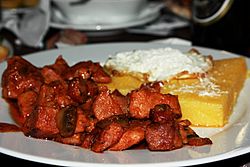Tochitură facts for kids
 |
|
| Type | Stew |
|---|---|
| Place of origin | Romania, Moldova |
| Main ingredients | Beef, pork, tomato sauce |
Tochitură (pronounced "toki'turə") is a yummy traditional dish from Romania and Moldova. It's made from pork cut into small cubes. The name "tochitură" comes from the Romanian verb "a topi," which means "to melt" or "to slow-fry meat in fat." This dish is cooked slowly in its own fat and juices, often in a special cast-iron pot.
Tochitură is usually served with "over-easy" eggs (eggs fried on one side with a runny yolk) and mămăligă. Mămăligă is a type of porridge made from cornmeal, similar to polenta. There are different kinds of Tochitură. For example, tochitură moldovenească is the version from the Moldavia region. The tochitură ardelenească is from the Transylvania region.
Contents
What is Tochitură Made Of?
Tochitură can be made in a few ways. It can have a little bit of tomato sauce, or no tomato sauce at all. While pork is common, it can also be made with beef, lamb, or even chicken. The type of meat often depends on where you are in Romania. For example, it might be different in Moldova, Transilvania, Oltenia, Muntenia, or Dobrogea.
Cooking Style
Tochitură is not exactly a stew, even though it might seem like one. The amount of tomato sauce, if used, is very small. It's usually added right at the end of cooking. This way, the meat cooks mostly in its own natural juices and fat.
The version with tomato sauce is very popular today. You'll find it in most restaurants. However, the older, more traditional way of making it doesn't use tomato sauce. Instead, it has a rich sauce made from the pork fat and meat juices.
Traditional Ingredients
A very traditional Romanian Tochitură uses more than just plain meat. It can include other parts of the animal. These might be liver, kidneys, or heart. It can also have pork fat, also known as slănină, or bacon. Smoked sausages are sometimes added too. All these ingredients are fried together slowly.
How to Enjoy Tochitură
When Tochitură is served, it always comes with mămăligă. It is also often served with a salty sheep cheese. This cheese can be either telemea or brânză de burduf. These cheeses add a delicious salty flavor that goes well with the rich meat dish.
See also
In Spanish: Tochitură para niños

